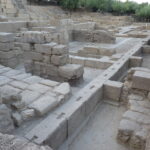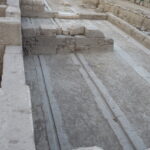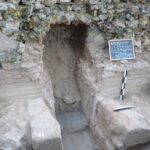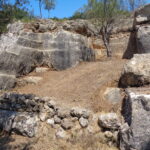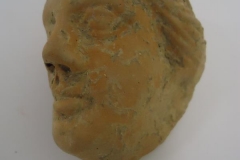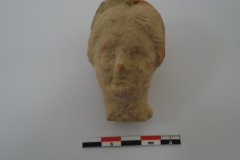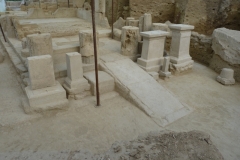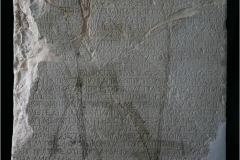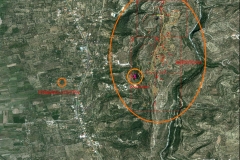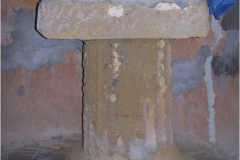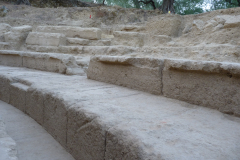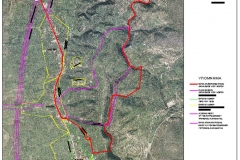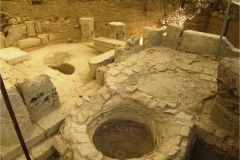During the year 2020 the excavation research in the ancient theater of Thouria brought to light the entire skenotheke, with internal dimensions: 21,50X7,80m (FIG. 1).
On the floor of the skenotheke three stone grooves of the movable skene of the theater are preserved in an exceptionally good state of preservation (FIG. 2).
The northern narrow side of the skenotheke is occupied by a later paved floor made of rectangular stone slabs in second use (with dimensions 6,50X2,50m) (FIG. 3). The paved construction is connected obviously with the later (of the Byzantine period) use, during which four living areas or storerooms were constructed inside the skenotheke, with the building of transverse partition walls made of ancient architectural members.
After the complete reveal of the stone grooves, it was found that their total length, which occupies the entire area of the skene and the skenotheke is 48m (FIG. 4, Aerial Figure).
To the southwest of the theater’s skene, a circular well with a stone mouth (diam. 2,20m, depth 4,50m) was revealed, in which the rainwater of the orchestra’s drainage channel ended, through a stone carved groove (FIG. 5).
The research at the northern and southern lower end of the theater’s hollow, brought to light many parts of the stone seats, some of which were found intact, but removed in later years by their original position (FIG. 6).
During the test excavation trenches that were carried out on an adjacent field to the S-SW of the ancient theater, part of a large public building with direction N-S was revealed at a depth of about 0,50m from the surface of the ground, carefully constructed of large stone blocks built in isodomic masonry, with a vey elaborate façade.
The excavation in another area in the same field brough to light the ruins of a bath complex of the Roman-Late Roman period, preserved at a great height (FIG. 7).
Ancient Quarry. Site “Prionista”
For the first time systematic cleaning was carried out in an area of about 20 sq m, in the extremely extensive ancient quarry from which the building material for the monuments of ancient Thouria come. The quarry is located on the slopes of the hill, which is about 1-1,5 km to the north of the ancient city, with which it was connected in antiquity by a carriage road. The traces of this road have been found in many parts of the ancient city, where the rails for the chariots can be seen on the natural rock of the area. The research in the quarry revealed the stepped façade of stone extraction (height 3,80m), as well as the quarrying traces (FIG. 8).
Dr. Xeni Arapogianni
March 2021

